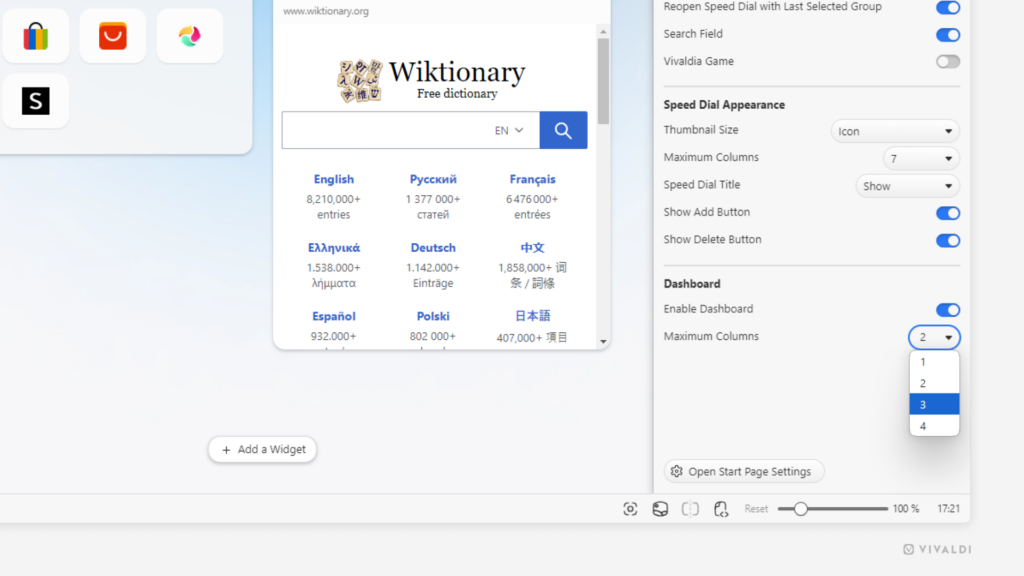Desktop Tips
Tip #610
December 4, 2024
Reopen closed Web Panels instead of adding them again.
Adding new Web Panels is pretty straightforward in Vivaldi, but when it’s a Web Panel you’ve already had on your browser’s sidebar, it’s even easier to restore it.
To reopen a Web Panel:
- Right-click on one of the Panel buttons.
- Select “Closed Web Panels”.
- Click on the closed Web Panel you want to add back to the sidebar.
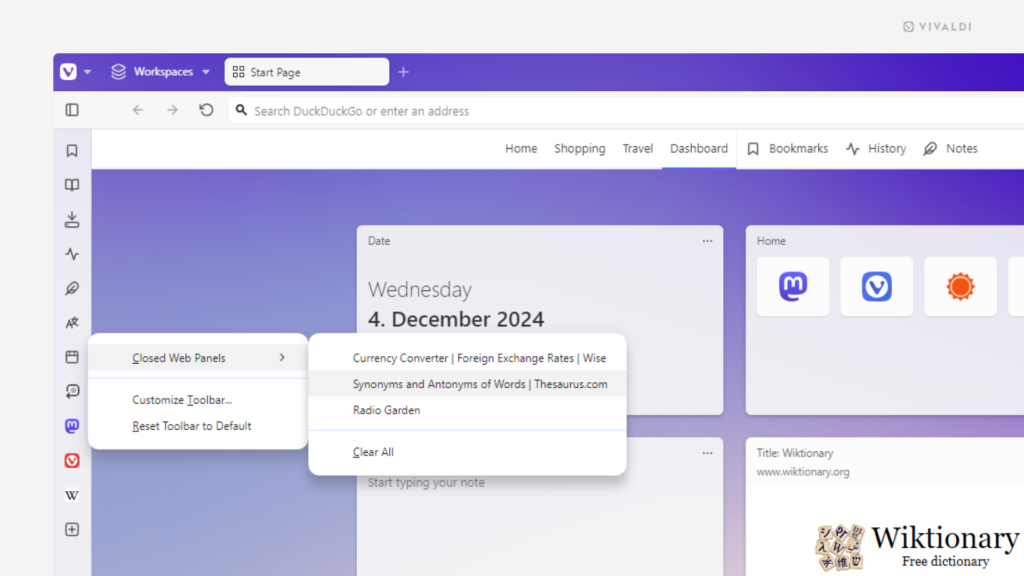
Tip #606
November 28, 2024
Sort your browsing history by page title, address or view count, in addition to chronologically.
You don’t need to go through your browsing history in chronological order to find a visited web page, though, admittedly it’s easier to find the page when you start seeing other pages you visited around the same time.
To sort history in the History Panel:
- Open the History Panel.
- Above the list of entries, click on “Sort by Date”.
- Select between:
- Sort by Title
- Sort by Address
- Sort by Page Views.
- Optionally, switch sorting from ascending to descending or vice versa.
To sort history in the History Manager:
- Open the History Manager.
- Click on the column header you want to sort by.
- Click again to reverse the order.

Tip #604
November 26, 2024
Decide which outgoing emails should get your signature and which should not.
A signature is a personalized section that is automatically added to the end of messages you send from Vivaldi Mail. When you’ve created a signature in Mail settings it’ll be added all new emails you start writing. Optionally, you can add the signature also to reply emails and emails you’re forwarding.
To review signature settings:
- Go to Settings > Mail > Mail Accounts.
- Select an account.
- Add a signature, if you don’t have one already.
- Below the signature input field, decide whether, in addition to new emails you write, you also want to include the signature in replied and forwarded messages.
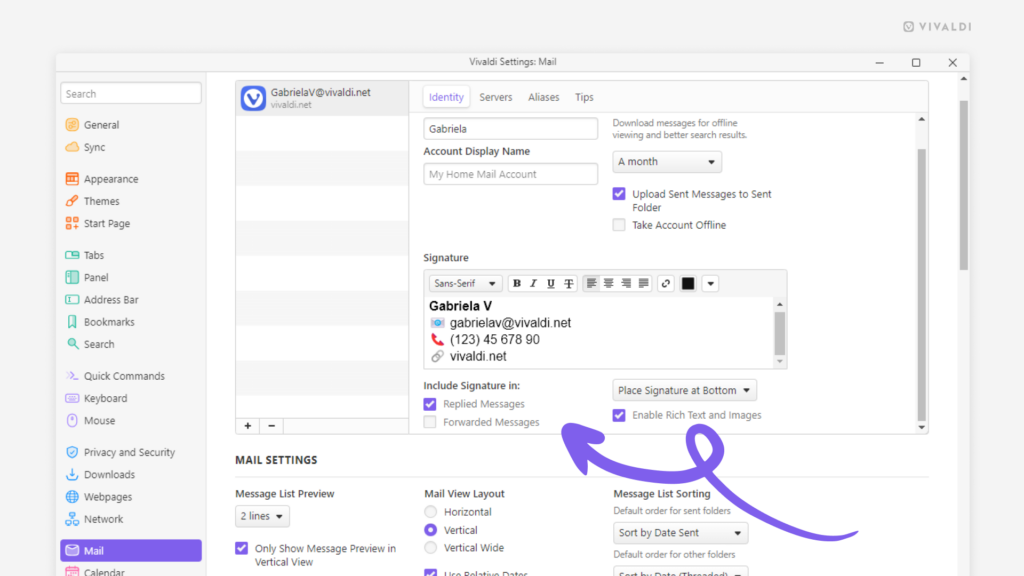
Tip #602
November 22, 2024
View and access your most visited websites from the Top Sites Dashboard widget.
Top Sites offer a quick access to the sites you visit most often. Based on your browsing history, this feature ensures you spend less time searching for the websites you frequently use.
To enable Top Sites:
- Go to the Dashboard.
- Click on “Add Widget” at the bottom of the page.
- Click on “Top Sites”.
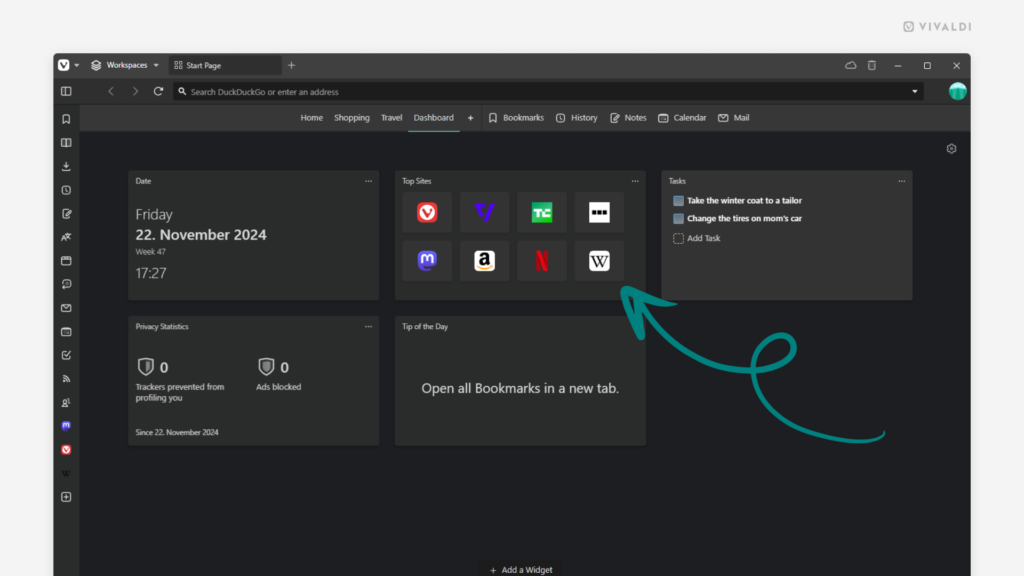
Tip #600
November 20, 2024
Create Keyboard Shortcuts for opening and closings individual Web Panels.
Keyboard Shortcuts are excellent for opening and closing Web Panels for a quick glance. But before you toggle Web Panels with Keyboard Shortcuts, you need to assign each panel its unique shortcut.
To add Keyboard Shortcuts:
- Go to Settings > Keyboard Shortcuts > View.
- Find the command “Web Panel 1”.
- Click in the box next to it.
- Press the keys you want to use for the shortcut on your keyboard.
- Repeat with other Web Panels.
Then whenever you want to open one of the web panels just use the shortcut for both opening and closing the panel. If you already have one open, the shortcut will switch focus to the one you need.

Tip #599
November 19, 2024
Choose whether to open the Start Page with the last viewed Speed Dial Group or with the first one on the list.
Start Page with the Speed Dials and Dashboard is a starting point in every new Vivaldi tab for most people. To make it useful, choose what you want to see.
To make your decision:
- Go to Settings > Start Page > Reopen Speed Dial with.
- Choose between “Last Selected Group” and “First Group”.
If you’re opting for “First Group”, check out this recent tip on reordering your Speed Dial Groups.
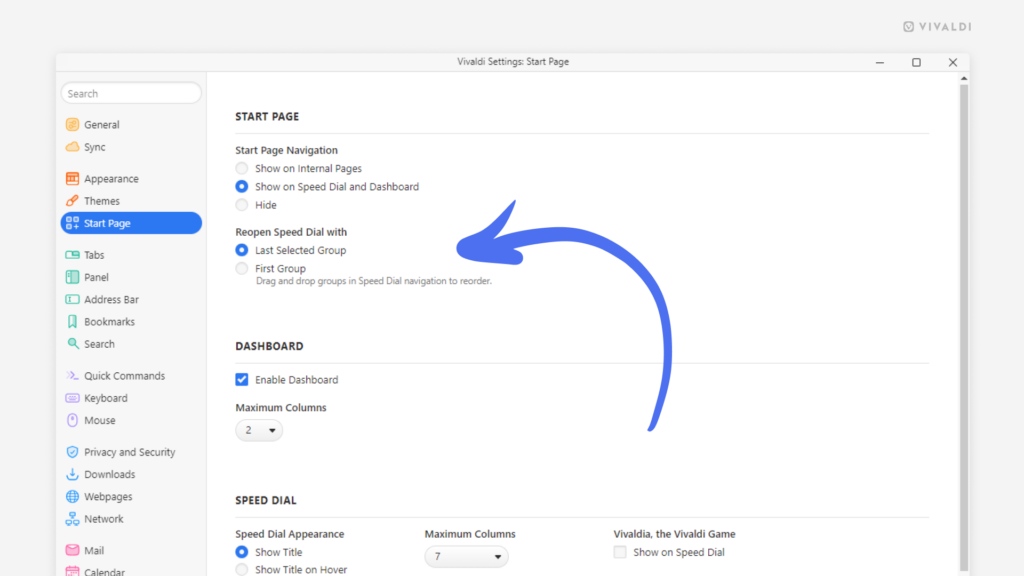
Tip #597
November 15, 2024
Restore recently deleted Calendar events from Trash.
When a cancelled event is back on, instead of creating a new event in your Vivaldi Calendar you can simply restore the one you deleted.
To restore an event:
- Open the main Calendar view.
- Click on
 “Trashed Events” in the top right corner of the calendar.
“Trashed Events” in the top right corner of the calendar. - Click on the event you want to restore.
To restore the most recently deleted event, right-click on any of the timeslots in the Calendar and select “Restore Event From Trash”.
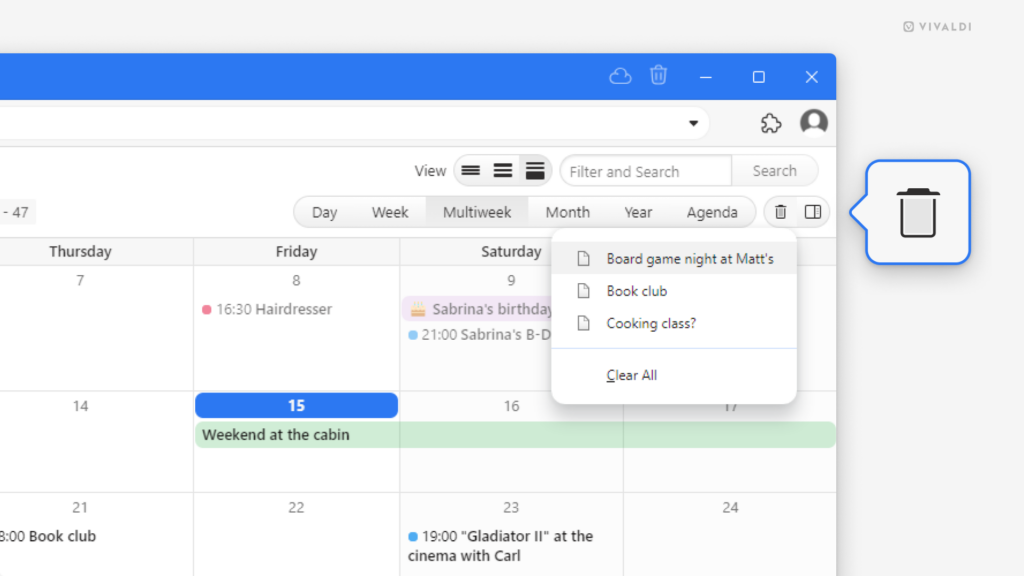
Tip #595
November 13, 2024
Put your Speed Dial Groups on the Start Page into the correct order.
Have you added many bookmark folders as Speed Dials on the Start Page, but the order is all wrong, and/or you’d prefer to have the Dashboard as the first page rather than the last? Don’t fret! There’s a super easy way to get them in the correct order.
To reorder your Speed Dial Groups and the Dashboard:
- Click on the group you want to move and start dragging it right or left.
- Using the vertical line as a guideline, drop the group at its new location on the Start Page Navigation bar.
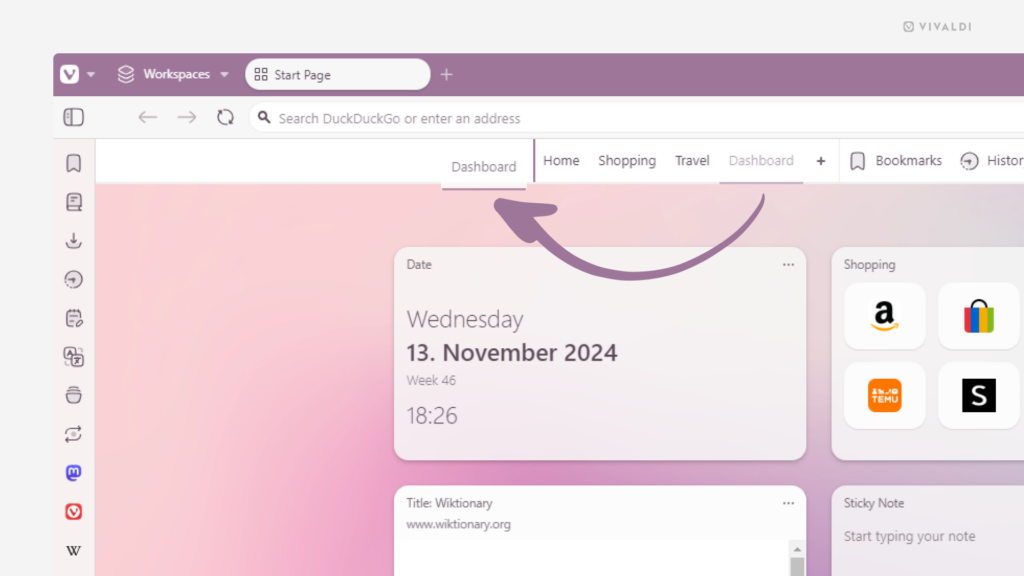
Tip #594
November 12, 2024
Trigger Command Chains from a toolbar button with a custom icon.
Command Chains can be triggered with Quick Commands, Keyboard Shortcuts, Mouse Gestures, toolbar buttons, and from menus. Command Chain toolbar buttons all look the same, though. If you have multiple chains on the browser’s toolbars, you should give them custom icons to make them easier to recognize.
To give a Command Chain button a custom icon:
- Go to Settings > Themes > Editor > Icons.
- Select the icon you want to update.
- Drag the file to the preview box.
Alternatively, click on the box and locate the file.
To add a Command Chain to a toolbar:
- Go to the Vivaldi menu > View > Customize Toolbar.
Alternatively, right-click on one of the buttons already on the toolbar and select “Customize Toolbar”. - From the drop-down menu, select “Command Chains”.
- Drag the chain’s button to the toolbar of your choice.
Tip #593
November 11, 2024
Create custom widgets for the Dashboard with the help of Webpage Widgets.
There are different widgets you can add to the Dashboard in your Vivaldi browser – Feeds, Tasks, Bookmarks, etc. The Webpage Widget offers you the most flexibility, allowing you to add any webpage to the Dashboard (preferably one that looks good in a small web view).
To add a Webpage Widget:
- Go to the Dashboard.
- Click on “Add Widget” at the bottom of the Dashboard.
- Select “Webpage”.
- Enter the link of the website you want to view from the widget.
- Click “Done”.
In the image below, you can see two webpage widgets on the bottom row. The widget on the left is a web page with a game and the one on the right shows the widget setup process.
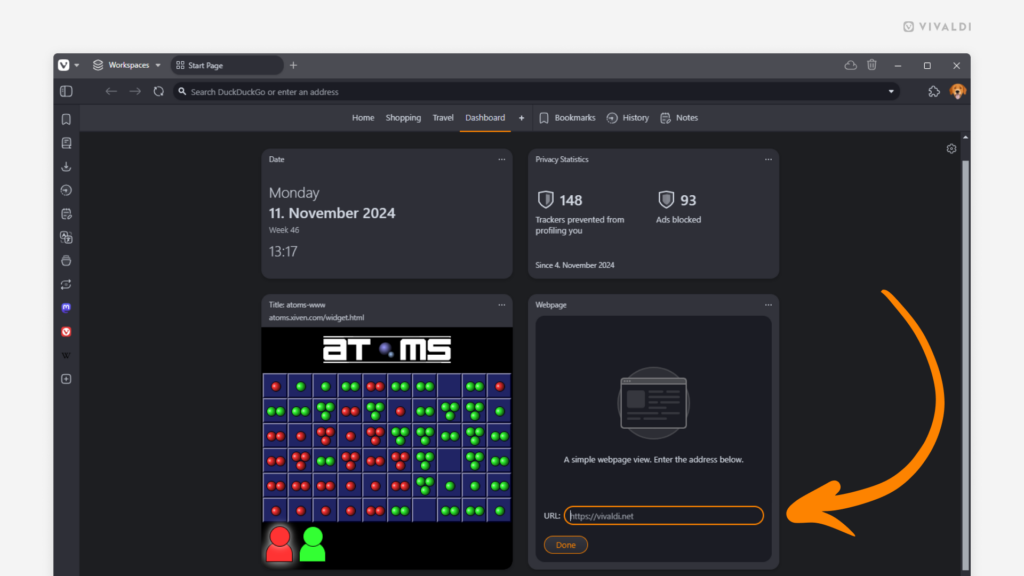
Tip #590
November 6, 2024
Open bookmarks from the Bookmark Panel with a single click.
Having to do a double click instead of a single click doesn’t seem like a big deal, but you’d be surprised how even the most minuscule differences can affect your workflow.
To enable bookmark opening with a single click:
And how about combining it with the “Open Bookmarks in New Tab” setting, which you’ll find right above “Open Bookmark Panel Items with Single Click”?
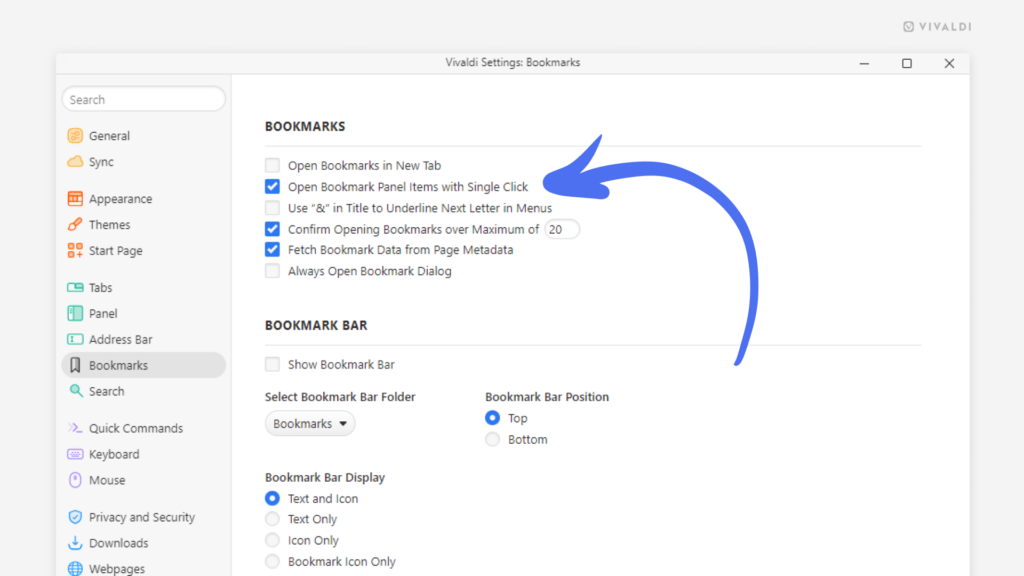
Tip #589
November 5, 2024
Choose the maximum number of widget columns for your Dashboard.
The same way you can decide how many Speed Dial columns you have on the Start Page when the browser window is large enough to fit a lot of them (see Tip #89), you can choose how many columns of widgets you have on the Dashboard.
To update the limit:
Option 1
- Click on “Show Start Page Settings” in the top right corner of the Start Page.
- In the Dashboard section, choose a number between 1-4 for “Maximum Columns”.
Option 2
- Go to Settings > Start Page > Dashboard.
- Choose a number between 1-4 for “Maximum Columns”.
